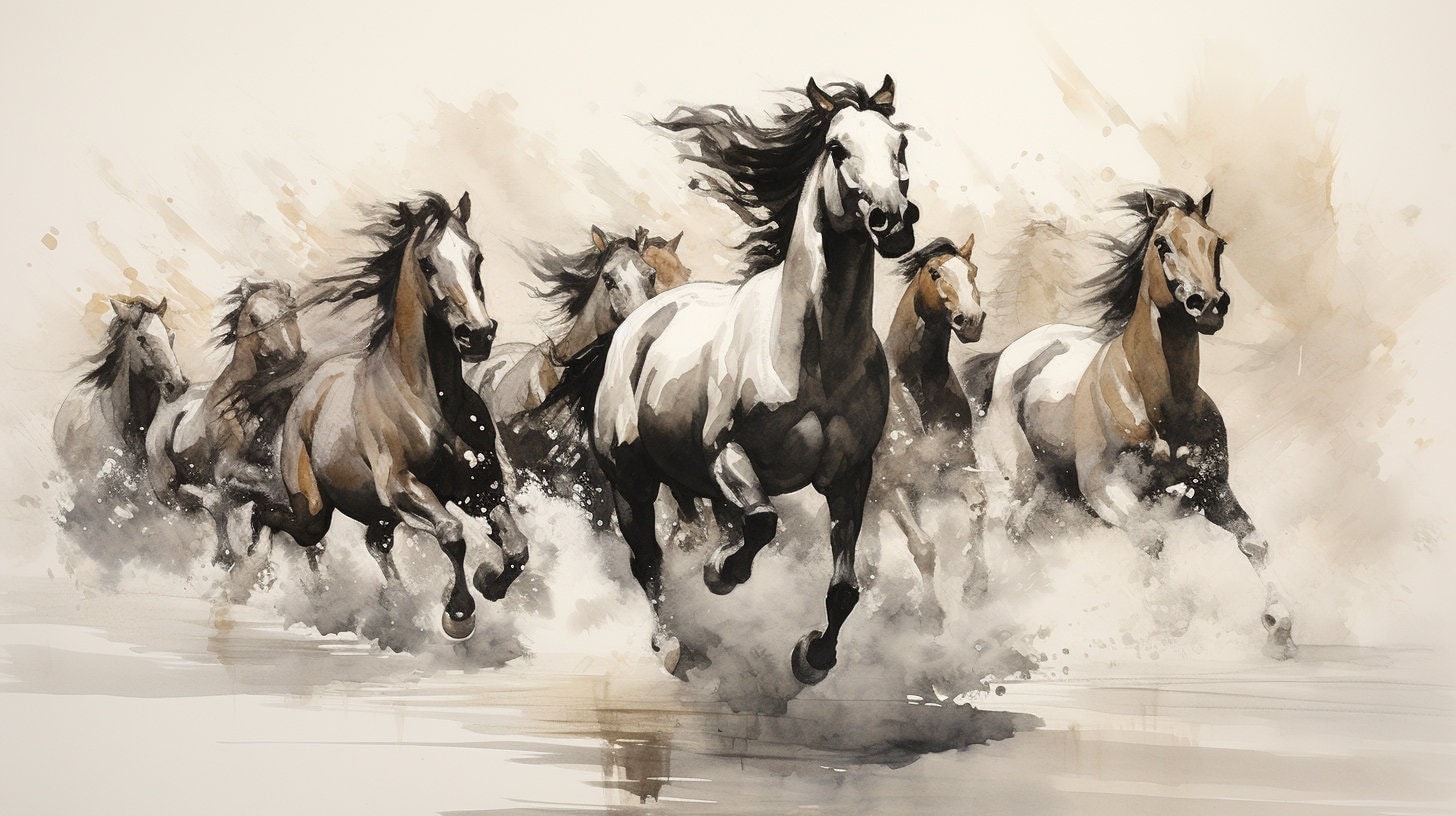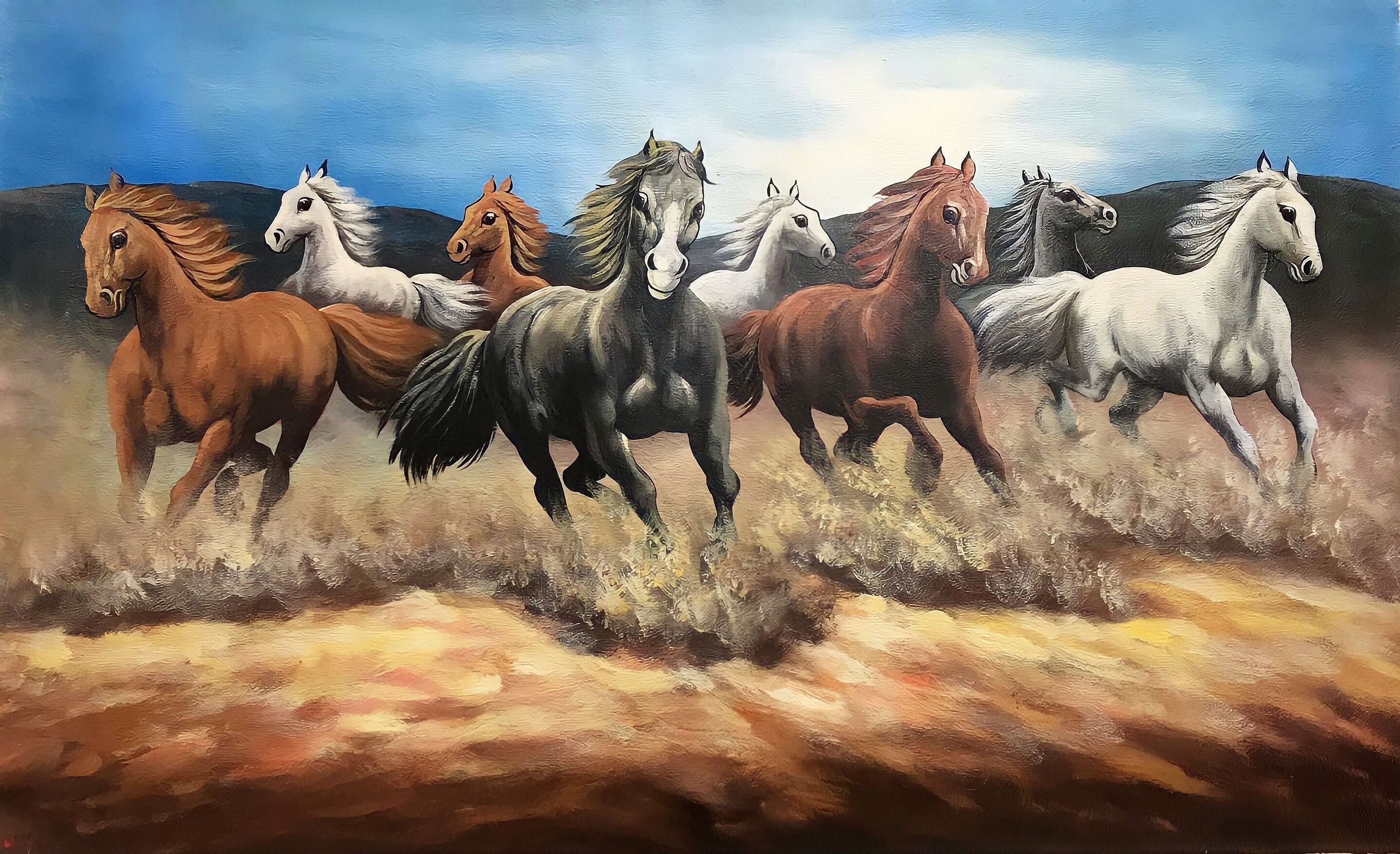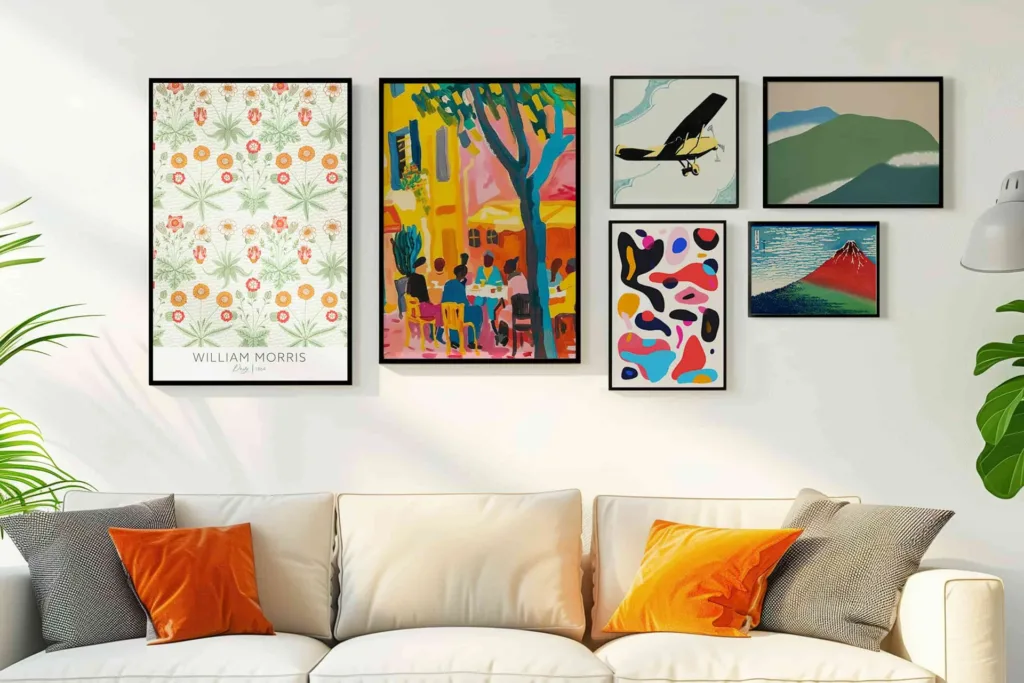News
Galloping Inspiration: Bringing the Spirit of Horses into Your Home with Equine Art
Part 1: The Emotional and Aesthetic Appeal of Equine Art
Equine art has held a timeless place in human culture, capturing the grace, power, and spirit of horses across centuries. From ancient cave paintings to modern acrylic masterpieces, horses have been celebrated for their elegance, strength, and symbolic resonance. Bringing equine art into your home is more than a decorative choice; it is an opportunity to connect with movement, freedom, and emotion. This section explores why equine art inspires and how it enriches the emotional and aesthetic landscape of interior spaces.
1. Why Horses Captivate Humanity
Horses have long held a special place in human imagination. Their presence in art reflects admiration, reverence, and connection.
Symbol of Freedom and Power: Horses embody unbridled freedom, movement, and vitality. Artworks depicting galloping horses evoke a sense of liberation, inspiring viewers to embrace ambition and courage in their own lives.
Elegance and Grace: The flowing lines of a horse in motion, the contours of its musculature, and the dynamic interplay of light and shadow highlight the natural elegance of these creatures. Artists have long celebrated these qualities to create works that combine realism with aesthetic beauty.
Cultural and Historical Significance: Horses have played pivotal roles in transportation, agriculture, war, and sport. Equine art often carries historical or cultural layers, reflecting human reliance, admiration, and mythological connections to horses.
Emotional Resonance: The intelligence and expressive features of horses—alert eyes, poised ears, and flowing mane—evoke empathy, admiration, and inspiration. These qualities make equine art emotionally compelling and universally appealing.
2. Psychological Benefits of Equine Imagery
Equine artwork offers mental and emotional enrichment beyond aesthetic pleasure.
Inspiration and Motivation: Dynamic images of horses in motion foster feelings of energy, courage, and ambition. The visual representation of strength and determination can inspire personal growth, focus, and resilience.
Calm and Reflection: Serene depictions of grazing horses, quiet stables, or pastoral scenes encourage relaxation and contemplation. These compositions evoke peace, mindfulness, and a connection to nature.
Emotional Connection: Horses symbolize loyalty, companionship, and empathy. Viewing equine art can trigger emotional reflection, reinforce a sense of compassion, and enhance overall well-being.
Creativity Stimulation: The complexity of a horse’s form, combined with expressive artistic interpretations, sparks imagination and creativity. Artists’ choices in color, movement, and composition inspire viewers to see beyond the literal subject, stimulating artistic and emotional thought.
3. Aesthetic Principles in Equine Art
Equine art balances form, movement, and composition, making it visually compelling.
Movement and Dynamics: The depiction of a horse in motion—galloping, trotting, or rearing—creates energy and rhythm within a painting or sculpture. Skillful use of lines and perspective conveys momentum, drawing viewers into the scene.
Form and Anatomy: Mastery of equine anatomy allows artists to portray musculature, bone structure, and natural proportion realistically, enhancing the artwork’s authenticity and aesthetic appeal.
Light and Shadow: Effective use of lighting emphasizes texture, depth, and dramatic effect. Highlights on the horse’s coat, mane, and surroundings create contrast and bring the image to life.
Color Palette: Color choices significantly influence mood. Warm earthy tones evoke intimacy and warmth, while cool blues and grays convey serenity. Bold, high-contrast palettes enhance drama and energy.
Perspective and Composition: Composition techniques guide the viewer’s eye and establish focal points. Diagonal lines, leading edges, and horizon placement create depth, narrative, and dynamic engagement.

4. Symbolism in Equine Art
Horses carry rich symbolic meanings, allowing artworks to communicate stories and values.
Strength and Courage: A rearing stallion symbolizes power, resilience, and determination. These qualities resonate emotionally, encouraging viewers to embrace challenges.
Freedom and Adventure: Galloping horses represent liberation and exploration, inspiring a sense of independence and ambition.
Harmony and Partnership: Depictions of horses with humans or in herds symbolize connection, trust, and cooperation. These compositions evoke community and empathy.
Nobility and Prestige: Horses have long been associated with status and elegance. Artworks highlighting equestrian culture or ceremonial horses convey sophistication and timeless appeal.
Spiritual Significance: In some traditions, horses symbolize the soul’s journey, strength of spirit, or transformative energy. These elements enrich equine art with depth beyond visual appeal.
5. Types and Styles of Equine Art
Equine art spans diverse mediums and stylistic approaches, allowing homeowners to select pieces that suit personal taste and interior design.
Realistic Paintings: Focus on precise anatomy, texture, and environment. Perfect for classical or traditional interiors, realistic equine art conveys elegance and authenticity.
Impressionistic Interpretations: Loose brushstrokes and atmospheric effects capture movement and emotion rather than exact detail. These works infuse energy and poetic expression into contemporary or eclectic spaces.
Abstract Equine Art: Emphasizes color, shape, and emotion over literal representation. Abstract depictions allow for interpretation, complement modern interiors, and create conversation pieces.
Sculptures: Three-dimensional representations of horses add tactile depth and visual interest. Materials such as bronze, wood, or resin create dramatic focal points in living rooms, offices, or galleries.
Mixed Media and Digital Art: Combining traditional techniques with modern media, these works offer layered textures and innovative interpretations, ideal for eclectic or avant-garde spaces.
Photography and Prints: High-quality photographs or digital prints capture moments of motion, elegance, or natural beauty. They provide accessibility, affordability, and versatility in display.
6. Connecting Emotionally with Equine Art
Choosing equine art is deeply personal. Emotional resonance ensures that the artwork enhances your living space meaningfully.
Personal Experiences: Horses often evoke memories—riding experiences, farm life, or wildlife encounters. Artwork capturing these moments adds intimate significance.
Inspirational Themes: A horse galloping through a misty field or racing across a sunset beach can represent personal aspirations, courage, or freedom, fostering motivation and reflection.
Mood Alignment: Consider whether the artwork should energize, calm, or inspire. Dynamic motion inspires action and excitement, while serene pastures and quiet stables promote relaxation and introspection.
Storytelling: Equine art can narrate journeys, companionship, and life lessons. Grouped works or triptychs create a visual narrative, engaging viewers with sequential stories of movement, growth, and emotion.
7. Integrating Equine Art into Home Aesthetics
Equine artworks harmonize with diverse interior styles, enhancing visual and emotional appeal.
Traditional Interiors: Realistic paintings, oil depictions, or bronze sculptures of horses complement classic furniture, warm wood tones, and formal layouts.
Contemporary Spaces: Abstract or impressionistic equine art introduces dynamic energy and modernity, creating bold focal points on minimalist walls.
Rustic and Country Homes: Pastoral horse scenes, equestrian culture, and muted palettes align perfectly with country-style décor, natural wood, and earthy textures.
Eclectic Arrangements: Mixing equine art with other thematic pieces allows storytelling, dynamic contrast, and layered visual interest.
Home Offices and Studios: Inspirational equine artworks stimulate focus, creativity, and emotional engagement, fostering productive and reflective environments.
8. Light, Space, and Atmosphere
Lighting, placement, and spatial considerations are crucial for maximizing the impact of equine art.
Natural Light: Highlights textures, colors, and movement, enhancing realism and vibrancy. Avoid direct sunlight that may fade pigments over time.
Accent Lighting: Adjustable spotlights or picture lights emphasize key features, like a horse’s flowing mane or muscular structure, adding depth and drama.
Room Atmosphere: Consider wall color, furniture placement, and room function. Bright, dynamic artworks energize communal areas, while serene depictions enhance relaxation in private spaces.
Perspective and Viewing Angles: Position artworks where viewers can appreciate composition, scale, and detail without obstruction. Multi-dimensional sculptures benefit from strategic angles for optimal effect.
9. Emotional Impact Through Movement and Energy
The depiction of horses in motion creates energy and narrative flow in interiors.
Galloping Horses: Represent freedom, vitality, and dynamic energy, ideal for living rooms or creative spaces.
Trotting or Standing Horses: Evoke calm, stability, and balance, suited for bedrooms, studies, or contemplative areas.
Herds and Groups: Suggest community, harmony, and interaction, emphasizing social connection and storytelling.
Single Figures: Focus attention on individuality, strength, and personal aspiration, providing inspiration and emotional resonance.
10. Conclusion: The Enduring Appeal of Equine Art
Equine art transcends trends, offering timeless beauty, emotional richness, and symbolic depth. Horses embody freedom, strength, elegance, and resilience, and artworks capturing these qualities inspire, calm, and energize living spaces. Through careful selection of theme, style, color, scale, and medium, homeowners can integrate equine art meaningfully into their interiors, creating immersive experiences that connect emotion, aesthetics, and personal narrative.
Whether through a dramatic gallop across the canvas, a quiet stable scene, or a majestic sculpture, equine art celebrates life, movement, and the spirit of the horse, turning a house into a sanctuary of beauty, inspiration, and timeless elegance. By embracing its dynamic and symbolic qualities, homeowners cultivate spaces that reflect personality, spark imagination, and honor the enduring allure of horses in human culture.
Part 2: Selecting the Right Equine Artwork
Choosing the right equine artwork for your home is an art in itself. The perfect piece does more than decorate a wall; it reflects your personality, enhances the emotional atmosphere of a room, and celebrates the grace, strength, and spirit of horses. With countless styles, mediums, and subjects available, selecting equine art requires careful consideration of both aesthetic and personal factors. This guide explores the key elements to consider when curating equine artwork for your home.
1. Understanding Your Space and Its Purpose
Before choosing equine art, consider the function of each room and how the artwork will interact with the space.
Living Rooms: As communal areas, living rooms benefit from statement pieces that draw attention and spark conversation. Large-scale paintings of galloping horses, dynamic herds, or expansive pastures serve as focal points and bring vitality to the space. Consider the color palette of your furniture and walls to ensure the artwork complements and elevates the room’s overall design.
Bedrooms: Bedrooms are personal retreats, so equine art should promote relaxation and emotional comfort. Gentle scenes of grazing horses, serene landscapes, or calm stables encourage peace and introspection. Soft hues like pastels, muted browns, and warm neutrals work well to create a soothing environment.
Home Offices and Studios: Creative spaces are ideal for dynamic, energizing equine art. Images of horses in motion—galloping across open fields, rearing against dramatic skies, or racing with wind-swept manes—stimulate imagination, focus, and ambition. Color psychology is crucial here: blues and greens enhance concentration, while warm tones like golds and reds energize the mind.
Entryways and Hallways: Transitional areas are perfect for medium-sized equine pieces that make a strong first impression. Scenes of horses in motion, herds on the horizon, or close-up portraits create intrigue, welcoming guests and establishing the home’s tone.
2. Choosing Themes and Subjects
Equine art encompasses a wide array of themes and subjects. Choosing one that resonates with your personal taste, emotional needs, and lifestyle is essential.
Galloping Horses: Symbolizing freedom, energy, and motion, these images inspire movement and ambition. Perfect for areas where you want to evoke excitement or motivation.
Pastoral Scenes: Horses grazing in fields or standing peacefully in stables evoke tranquility and harmony. Ideal for bedrooms or meditation spaces.
Equestrian Activities: Scenes depicting horse riding, dressage, or jumping combine elegance with action, appealing to enthusiasts and creating a narrative of mastery and connection between human and animal.
Dramatic Landscapes: Horses set against stormy skies, mountain ranges, or coastal vistas convey intensity, resilience, and adventure. These pieces energize spaces and spark conversation.
Abstract and Impressionistic Representations: Focus on motion, emotion, and color rather than realistic depiction. These works suit modern interiors, allowing for personal interpretation and adding dynamic energy.
Individual Portraits vs. Herds: A single horse emphasizes individuality, strength, and personal aspiration, while herds symbolize community, teamwork, and harmony. Choosing between the two depends on the intended message and emotional tone.
3. Color Palette Considerations
Colors significantly influence the mood and visual harmony of equine artwork within a room.
Earthy Tones: Browns, ochres, and creams evoke warmth, natural beauty, and stability. They pair well with rustic, traditional, or country-style interiors.
Blues and Greens: Convey calm, balance, and serenity. Ideal for bedrooms, studies, or spaces intended for relaxation.
Warm Accents: Reds, oranges, and golds add vibrancy and energy, making dynamic horse compositions more dramatic and visually engaging.
Neutral Backgrounds: Beige, white, and soft gray tones allow the subject to shine while harmonizing with diverse décor elements.
High-Contrast Palettes: Strong contrasts in color can emphasize motion, depth, and focal points, perfect for statement pieces or central walls.
By thoughtfully selecting colors, you can ensure that equine artwork enhances emotional impact and blends seamlessly with existing décor.

4. Scale and Proportion
The size of equine artwork relative to its environment profoundly impacts visual harmony and emotional engagement.
Large-Scale Works: Expansive paintings or large sculptures of horses create immersive experiences, commanding attention and serving as central focal points. These pieces work well above sofas, beds, or mantels.
Medium-Sized Artworks: Versatile in placement, medium-sized pieces can complement other décor, form part of gallery walls, or be grouped into triptychs or series for narrative effect.
Small Pieces: Ideal for intimate spaces such as hallways, shelves, or desks. Smaller works encourage close observation and personal engagement without overwhelming a room.
Balance and Composition: Artwork should feel proportionate to furniture and wall dimensions. Too large or too small a piece can disrupt spatial harmony. Properly scaled artwork maximizes aesthetic appeal and emotional resonance.
5. Medium Selection
The medium affects texture, longevity, and visual impact.
Oil Paintings: Rich, textured, and timeless, ideal for traditional or classical interiors. Oils provide depth and realism, capturing musculature, motion, and light.
Acrylic Paintings: Versatile and vibrant, acrylics suit contemporary or modern interiors. Bold colors and layered techniques create dynamic visual experiences.
Watercolors: Delicate and subtle, watercolors are perfect for serene compositions. They offer softness, transparency, and gentle color transitions that promote calm.
Sculptures: Three-dimensional representations add tactile depth and dramatic impact. Materials like bronze, resin, or wood can become conversation pieces and centerpieces.
Prints and Photography: High-quality reproductions allow flexibility in placement, seasonal rotation, and budget-conscious choices. They also facilitate experimentation with different themes and sizes.
Mixed Media: Combining materials or techniques enhances texture and uniqueness, ideal for eclectic or avant-garde interiors.
6. Framing and Presentation
Framing is essential for protecting artwork and enhancing its visual impact.
Traditional Frames: Ornate wooden frames suit realistic paintings and classical interiors, adding elegance and refinement.
Minimalist Frames: Clean lines and neutral tones emphasize the artwork without distraction, complementing modern or minimalist spaces.
Floating Frames: Canvas artworks in floating frames achieve a gallery-like depth, emphasizing texture and form.
Matting: Mat boards provide breathing space around the artwork, enhancing composition and focus. Neutral mats suit soft scenes, while colored mats highlight accents.
Well-chosen framing ensures longevity, visual harmony, and professional presentation.
7. Personal Connection and Storytelling
The most impactful equine art is deeply personal and emotionally resonant.
Memories and Experiences: Choose artwork that reflects past experiences, such as riding, farm life, or memorable equestrian events.
Inspirational Themes: Dynamic or heroic depictions of horses can symbolize personal aspirations, freedom, courage, or resilience.
Mood Alignment: Consider whether the artwork should energize, calm, or inspire reflection. Aligning the mood of the piece with the space enhances emotional engagement.
Narrative Potential: Grouped works or series create storytelling arcs, allowing viewers to journey through emotion, movement, and symbolism across multiple pieces.
8. Coordinating Multiple Pieces
Combining multiple equine artworks creates visual narrative and layered interest.
Gallery Walls: Arrange several pieces of different sizes or perspectives to create cohesion and visual rhythm. Sequential or thematic arrangements enhance storytelling.
Theme Consistency: Maintain consistent subjects, such as horse breeds, landscapes, or motion styles, while allowing for variation in medium or interpretation.
Spacing and Symmetry: Thoughtful spacing ensures breathing room, prevents visual clutter, and enhances the overall flow. Symmetry or staggered arrangements can emphasize rhythm and energy.
Series and Triptychs: Curated sets of artworks depicting progression or sequences of motion immerse viewers and highlight the narrative quality of equine art.
_0_1200.jpg.webp)
9. Practical Considerations
Selecting equine artwork also involves practical factors that affect durability and display.
Lighting: Proper illumination enhances colors, textures, and details. Avoid direct sunlight that can fade pigments over time.
Placement Height: Hang artwork at eye level, approximately 57–60 inches from floor to center, adjusting for furniture and wall proportions.
Environmental Factors: Consider humidity, temperature, and sunlight exposure, especially for delicate media like watercolors or paper prints.
Rotation and Seasonal Display: Rotating artworks can refresh interior spaces. Display tranquil pastures in winter and dynamic gallops in summer to maintain engagement.
10. Final Thoughts on Selection
Selecting equine artwork involves a blend of aesthetics, personal resonance, and spatial awareness. By understanding your space, identifying themes, considering color, scale, medium, and framing, and prioritizing emotional connection, you can curate a collection that elevates your home and enriches daily life.
Thoughtfully chosen equine art does more than decorate; it inspires, energizes, and nurtures reflection, celebrating the strength, grace, and enduring spirit of horses. Whether through bold galloping compositions, serene pastures, or intricate sculptures, the right pieces transform walls into immersive experiences that convey movement, emotion, and narrative. By selecting with intention, homeowners create environments that are beautiful, meaningful, and deeply personal, celebrating both the artistic and symbolic power of equine imagery.
Beyond aesthetic and emotional considerations, selecting equine artwork also requires reflection on how it interacts with your daily environment. The scale of your life and personal routines should influence your choices. For instance, a large, dynamic painting of a galloping horse may energize a living area or home office, but in a bedroom, such intensity might be better balanced with softer, serene depictions to promote rest and relaxation. Similarly, placement relative to natural light, furniture, and sightlines ensures the artwork commands attention without overwhelming the room. Consider how people will encounter the piece: will it greet them upon entering, or invite quiet contemplation in a corner nook?
Another key factor is the narrative power of the artwork. Each piece tells a story—whether of freedom, resilience, or harmony—and that story should resonate with your own experiences and aspirations. Selecting art that evokes personal memories, inspires goals, or simply brings joy increases its long-term value beyond mere decoration. A series of pieces depicting motion or interaction among horses can create a visual journey that unfolds as viewers move through the room, turning your space into a dynamic, storytelling environment.
Lastly, investment in quality matters. Opt for materials and craftsmanship that ensure longevity, from durable canvases and archival-quality prints to finely crafted sculptures. Attention to detail in medium, frame, and finish not only enhances visual impact but preserves the beauty and emotional resonance for years to come. By carefully considering context, narrative, and quality, your equine art selection becomes a meaningful centerpiece—one that enriches your home, uplifts the spirit, and celebrates the enduring beauty and power of horses.

